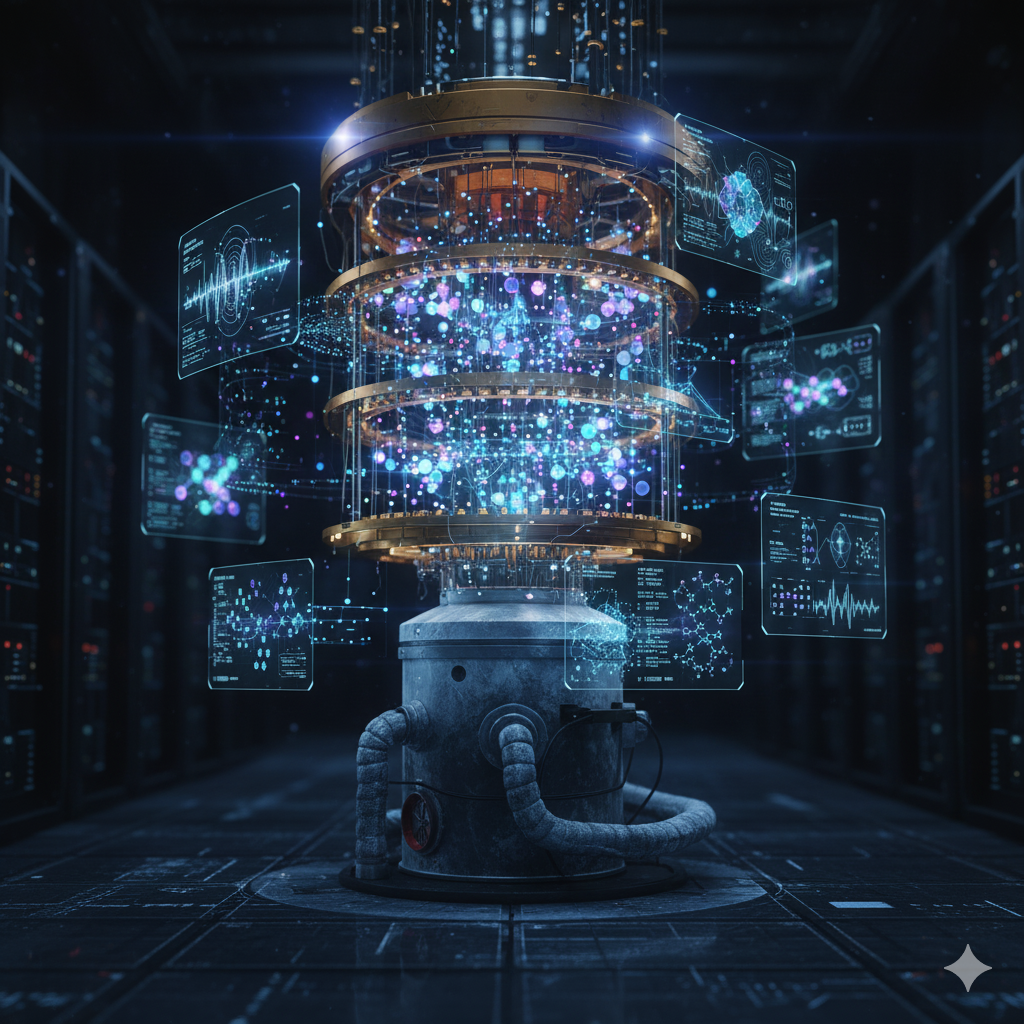For decades, quantum computing has been the stuff of science fiction—a futuristic concept promising world-changing power, perpetually hovering just over the horizon. But that horizon is now arriving. The theoretical “buzz” is rapidly being replaced by tangible, record-breaking hardware and practical, industry-specific applications. We are at an inflection point, moving from an era of classical computation to a new hybrid age where quantum’s unique power is beginning to solve real-world problems that have long been considered impossible.
This shift isn’t about quantum computers replacing your laptop to browse the web. Instead, it’s about a new class of machine designed to solve a new class of problem. From designing life-saving drugs to securing the global financial system, the quantum rise is poised to disrupt and redefine everything.
The Quantum Leap: Why It’s a Different Kind of Computer
To understand why quantum is so powerful, we must first understand its fundamental difference from the computers we use every day. Your smartphone or laptop operates on “classical bits”—tiny switches that can be in one of two states: a 0 or a 1. All modern computing is built on this binary, black-and-white logic.
Quantum computing uses “qubits.” A qubit leverages the strange and counterintuitive laws of quantum mechanics to exist in more than one state at once. This is called superposition, meaning a qubit can be a 0, a 1, or both at the same time.
When you link qubits, they can become entangled. Albert Einstein famously called this “spooky action at a distance.” When qubits are entangled, their states remain connected, no matter how far apart they are. Measuring one instantly influences the state of the other.
This combination of superposition and entanglement creates an exponential explosion in computing power. While two classical bits can represent just one of four possible states at a time (00, 01, 10, or 11), two entangled qubits can process all four of those states simultaneously. Three qubits can process eight states, and 300 qubits could represent more states than there are atoms in the known universe. This allows a quantum computer to run a “parallel” computation on a massive scale, exploring a vast landscape of possibilities all at once.
From the Lab to the Real World: The Hardware Matures
For years, the greatest challenge was building a machine that could control these delicate quantum states. Qubits are fragile; the slightest noise, vibration, or temperature change can cause them to “deco decohere” and lose their quantum properties, effectively “crashing” the calculation.
However, recent breakthroughs in 2024 and 2025 have shown that this barrier is being overcome. We are now in the “Noisy Intermediate-Scale Quantum” (NISQ) era, where we have machines with 50-100+ qubits that, while not yet fully error-corrected, are powerful enough to provide a “quantum advantage” for specific tasks.
In late 2025, Google’s Quantum AI division demonstrated a verifiable algorithm on its “Willow” quantum processor that was 13,000 times faster than the world’s most powerful classical supercomputer. Crucially, this wasn’t just a random demonstration of “quantum supremacy”; it was a “molecular ruler” algorithm with direct applications in materials science and drug discovery. Similarly, new photonic quantum chips, which use light (photons) instead of electricity, are promising 1,000-fold speed-ups for complex calculations. The hardware race is on, and the results are finally becoming commercially viable.
Application 1: Revolutionizing Medicine and Materials Science
The most immediate and profound impact of quantum computing will be in simulation. Why? Because our natural world—from molecules to materials—is governed by quantum mechanics. Classical computers are just bad at simulating it.
Drug and Cures: Today, discovering a new drug is a multi-billion dollar, decade-long process of trial and error. A key part of this is understanding protein folding. Many diseases, such as Alzheimer’s, Parkinson’s, and cystic fibrosis, are linked to proteins “misfolding.”
A quantum computer can simulate a molecule with perfect fidelity, “seeing” exactly how a protein will fold and how a potential drug will bind to it. Companies like Pfizer are already collaborating with IBM to model complex molecules, and Google’s “molecular ruler” breakthrough is designed for this exact purpose. This will allow scientists to design new, highly effective drugs in a fraction of the time, moving us toward a future of truly personalized medicine.
New Materials: The same principle applies to materials science. Do you want to create a new battery material that holds 10x more charge? A new catalyst that can pull carbon from the atmosphere efficiently? A new alloy for building lighter, stronger, and more fuel-efficient aircraft? A quantum computer can model the atomic interactions required to “design” these new materials from the ground up, rather than just discovering them by accident.
Application 2: Transforming Finance and Optimization
The second major area of impact is in solving complex optimization problems. These are problems with a mind-boggling number of variables, such as finding the most efficient route for a global supply chain or the ideal portfolio in a volatile market.
Finance: The financial industry runs on risk modeling. A common technique is the “Monte Carlo simulation,” where a computer runs millions of “what-if” scenarios to model a market’s potential future. A quantum computer can run all these scenarios at once. JPMorgan Chase and Amazon have already developed a “decomposition pipeline” that breaks down massive financial problems for quantum algorithms. This will allow for real-time risk analysis, fraud detection that spots patterns no classical AI could see, and portfolio optimization that truly maximizes returns while minimizing risk.
Logistics: Optimization is the heart of logistics. In 2024, DHL used a hybrid quantum approach to optimize routes for its international shipping, resulting in a 20% reduction in delivery times. Volkswagen is applying the same logic to manage city-wide traffic patterns, reducing congestion and emissions.
The Quantum Threat: A New Era for Cryptography
With all this power comes one massive, looming threat. Most of the world’s digital security—protecting your bank accounts, emails, and government secrets—relies on an encryption standard (like RSA) that is based on one simple fact: it is incredibly difficult for a classical computer to find the prime factors of a very large number.
A sufficiently powerful quantum computer, however, could run “Shor’s algorithm” and break this encryption in hours, not millennia.
This has triggered a global race to become “quantum-ready.” The solution is Post-Quantum Cryptography (PQC)—a new generation of encryption standards designed to be secure against attacks from both classical and quantum computers. This isn’t a theoretical exercise; the U.S. government and the European Union have both set 2030 deadlines for their critical systems to make this transition.
The Dawn of the Hybrid Age
We are not entering an age where quantum computers will replace classical ones. We are entering a hybrid age. Your classical computer will continue to handle email, spreadsheets, and streaming video. But for the world’s most complex challenges, it will act as a front-end, submitting the “impossible” part of the problem to a quantum processor.
The quantum age is no longer a distant dream. It has arrived. The experiments are off the whiteboard, and the technology is in the hands of chemists, financial analysts, and engineers. The impact of this shift will be as transformative as the invention of the classical computer itself, and the industries that harness its power first will lead the 21st century.

